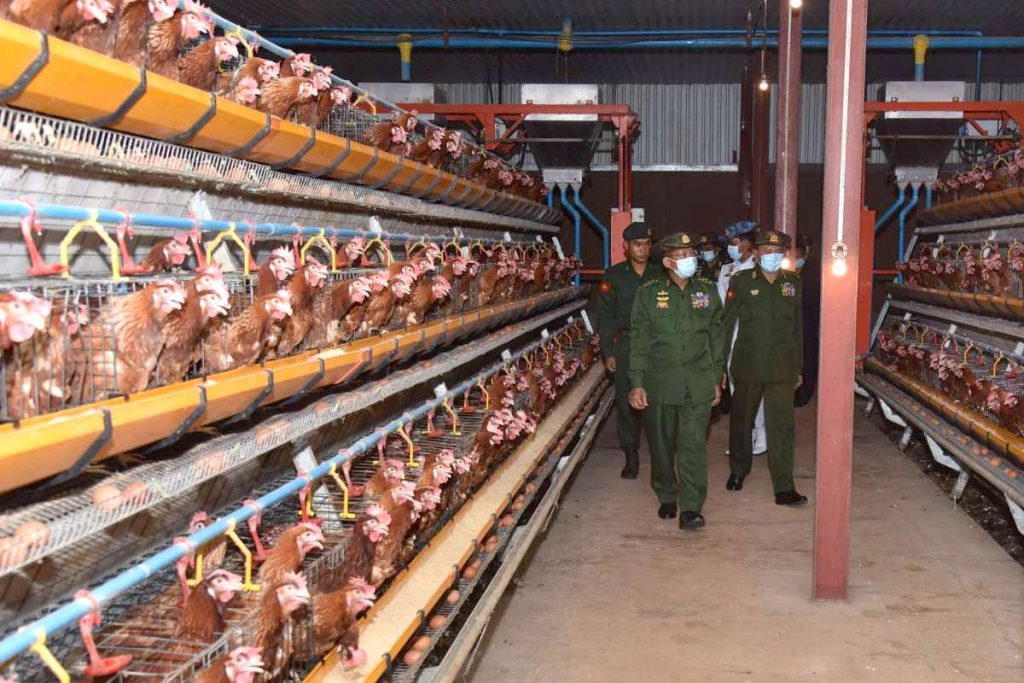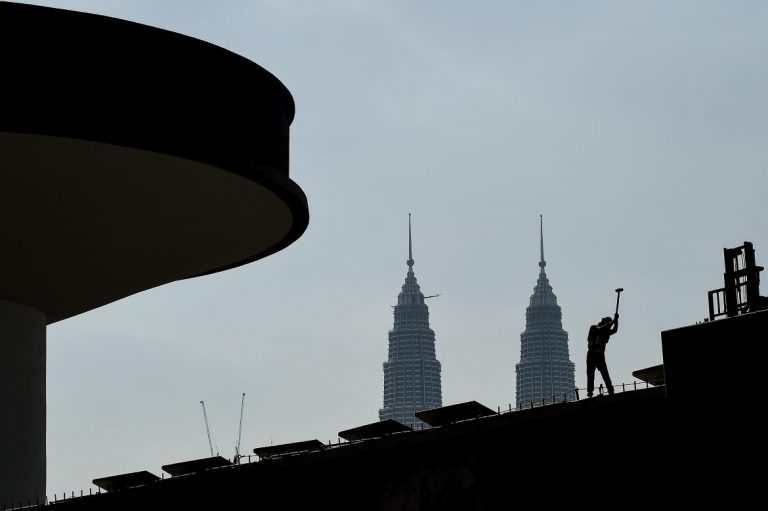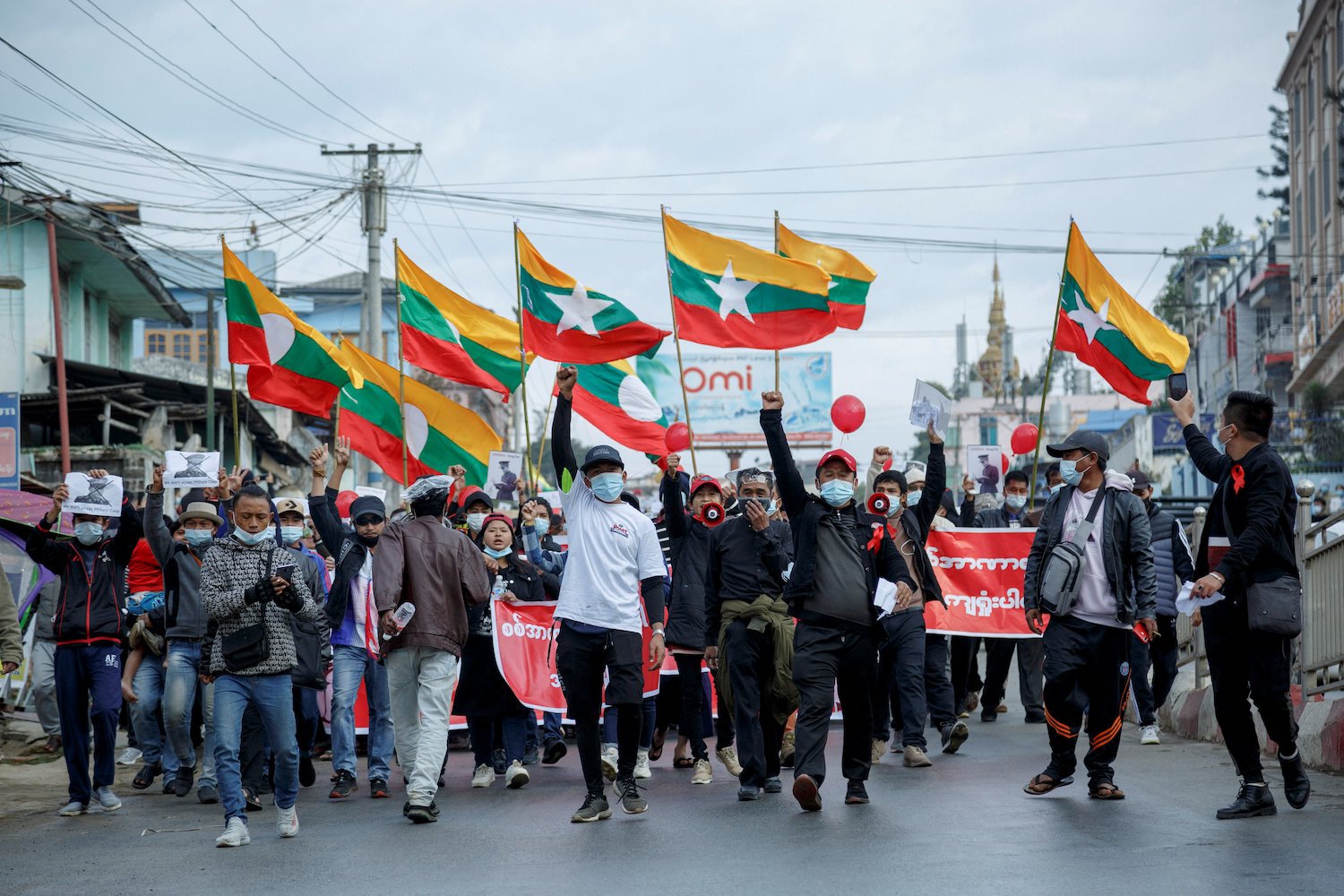The military regime is set to drop meaningful structural reforms from an economic recovery plan initiated by the former National League for Democracy government, and is instead promising to slash red tape in a bid to shore up collapsing business confidence.
By JOHN LIU and FRONTIER
When state media reported recently on the military regime’s plan to rebuild Myanmar’s slumping economy, the name of the plan had a familiar ring. So too did the jargon that went along with it.
The Myanmar Economic Recovery Plan was “based on the Sustainable Development Goals”, the Global New Light of Myanmar reported on August 26, and would have 10 “action plans”, 27 “expectations” and 407 “action lines”. Progress towards meeting key performance indicators would be assessed through a monitoring and evaluation process. Minister for Investment and Foreign Economic Relations U Aung Naing Oo has described it in multiple meetings as a “living document”.
If the language seems at odds with a regime struggling to cling to power in the face of both economic collapse and fierce, violent resistance to its rule, then there is a good reason. Much of the MERP is based on a document that the National League for Democracy administration was preparing prior to the February 1 coup, called the Myanmar Economic Resilience and Reform Plan, or MERRP.
The decision to drop the word “reform” from the title is no accident, though. It is also reflected in the body of the document, where most of the significant reforms contained in the draft MERRP have been removed.
The still-confidential draft plan instead focuses on trying to address the economic catastrophe by streamlining business regulations, digitising government services and reducing tax. It also seeks to revive the tourism industry and stabilise the banking sector, as well as support agriculture, livestock and fisheries. Unlike the MERRP and other economic plans introduced by the NLD government, it does not include any spending details or figures.
The MERP also does not mention the political and economic turmoil that has engulfed Myanmar as a result of the February 1 coup, including a slow-burning banking crisis and the flight of many foreign businesses, and instead pins Myanmar’s economic struggles entirely on the impact of COVID-19.
“With businesses and the economy affected severely by the COVID-19 pandemic, the Myanmar Economic Recovery Plan of the State Administration Council aims to revive the affected businesses, attract international and local investors and have firms be able to restart their operations,” reads the document.
The only reference to the coup is indirect, when the plan says that the SAC was “formed out of consideration of the current changing situation of the nation” and “is taking short-term control of the country’s affairs due to a state of emergency”.

Recovery, without the reform
In December 2020, the Myanmar Times reported that the NLD was working on a new economic plan to follow on from the Comprehensive Economic Relief Plan, which it unveiled in response to the first wave of the pandemic. The article cited a draft version of MERRP that the NLD administration had recently shared with development partners and the private sector.
The plan was never finalised because of the February 1 military coup, which saw the Tatmadaw detain senior NLD government officials and advisers, including State Counsellor Daw Aung San Suu Kyi, President U Win Myint, Minister for Planning and Finance U Soe Win, his deputy U Set Aung and Australian economic adviser Mr Sean Turnell.
Sources close to the NLD administration confirmed that the junta’s MERP lifts large sections from the economic plan the former government was working on prior to its ouster.
Frontier compared the Burmese-language draft of MERP with an English version of the unpublished MERRP and confirmed that much of the text was similar.
Some of the changes are subtle. The MERRP proposes strengthening the Central Bank of Myanmar’s exchange rate intervention mechanism to increase Myanmar’s foreign exchange reserves, “while preventing competitiveness-sapping currency over-valuation”. In the MERP, the latter part of the sentence has been replaced with “and enhance/boost foreign currency management”. Since the coup the junta has auctioned almost US$140 million to prop up the falling kyat, and has tried to intervene in other ways, such as by forcing businesses earning foreign currency to change it into kyat.
The MERP also has some new features, particularly in sections focused on tourism, taxation, and reform of laws, bylaws and procedures.
But the most significant change is the absence of important structural and governance reforms – many related to state finances – that deputy minister Set Aung had advocated for with the strong backing of former investment chief U Thaung Tun.
MERP instead focuses on cutting regulations and streamlining the business environment for companies. This reflects both the resistance from the Tatmadaw and its allies to the NLD’s reform agenda, and the fact that drafting has been overseen by minister Aung Naing Oo, who for many years headed the Directorate of Investment and Company Administration, with less input from the finance ministry.
The jettisoned reforms include a long-anticipated “project bank” to centralise infrastructure planning and vet infrastructure proposals, which advocates say would have encouraged greater transparency, better governance and ensured responsible investment.
On state-owned banks, MERRP contained a proposal “to expand existing rural lending” of two “newly merged and reinvigorated” state banks – the Myanma Economic Bank and Myanma Agricultural Development Bank – beyond crop loans secured by land title to “the full range of activities and agricultural production, storage and marketing chains”. In the new plan, this has simply been reduced to “expand existing rural lending and regular crop loan of the MEB/MADB”, suggesting both the merger of the banks and the expansion of products have been axed.
The MERRP also committed the government to issuing e-commerce regulations, advancing beneficial ownership transparency and land reform, all of which have disappeared.
Also dropped from the junta’s plan are a number of specific goals, such as submitting one new special economic zone proposal to parliament and initiating five strategic infrastructure projects.

The cost of the coup
The junta has also removed references to working with international organisations, or aspiring to meet international standards, such as the Financial Action Task Force’s regulations to combat money laundering and terrorist financing.
This is unsurprising given the Tatmadaw’s preoccupation with foreign involvement in the country’s political and economic affairs. The military and its allies have regularly made such allegations against billionaire financier Mr George Soros, and even occasionally institutions such as the World Bank and International Monetary Fund that were supporting reform initiatives.
Meanwhile, one of the most serious charges brought against Aung San Suu Kyi is under the Official Secrets Act, with Soe Win, Set Aung, Turnell and former finance minister U Kyaw Win as co-defendants. The exact nature of the alleged offence is unclear, but the charge criminalises the possession, collection, recording, publishing, or sharing of state information that is “directly or indirectly, useful to an enemy”.
Another key difference is that the MERP does not contain any spending details, which may be due to the country’s weakened financial position in the wake of the coup.
The economy was already suffering prior to the coup as a result of the first two waves of COVID-19. The NLD government had been forced to borrow $3 billion in the 2019-20 financial year, and was expecting its budget deficit to widen substantially in 2020-21 because of increased spending for its COVID-19 Economic Relief Plan (CERP) and falling revenues.
Its position though looks rosy compared to that which the regime finds itself in. The World Bank has estimated that the combined effects of COVID-19 and the coup are likely to cause the economy to contract by 18 percent this financial year. Tax revenues have crashed, in part because of boycotts, and loans and assistance from multilaterals are no longer a possibility.
Although the junta pledged shortly after taking power not to alter the foreign and economic policies of the ousted administration, investors have been far from convinced. Many have scaled back plans or even left the country entirely because of instability, operational challenges, human rights concerns, and restrictions and edicts announced by the regime.
The list is long and varied. Work has been suspended on Yoma Central, a $700 million commercial development project in downtown Yangon. China’s Ant Group, a subsidiary of Alibaba, has cancelled its planned US$75 million-plus investment in mobile wallet Wave Money, while in July Norwegian company Telenor announced it was selling its entire operation to the M1 Group of Lebanon for a fire-sale price of US$105 million, valuing the company at barely $500 million. Hong Kong-listed VPower recently halted two out of its nine power plant projects in Myanmar, and earlier this month German wholesaler Metro announced it would be ceasing operations by October.
Lack of consultation
In recent months the MERP has been circulated to the Union of Myanmar Federation of Chambers of Commerce and Industry (UMFCCI), the country’s peak business body, but does not seem to have been distributed more widely.
The UMFCCI was targeted by protesters in February after senior members travelled to Nay Pyi Taw for a meeting with junta chief Min Aung Hlaing. It then suspended its operations, although state media has still reported multiple meetings between its president, U Zaw Min Win, and military officials.
The state-run Global New Light of Myanmar reported that the Ministry of Investment and Foreign Economic Relations held a virtual consultation on MERP with UMFCCI officials on September 1, at which Zaw Min Win gave a briefing “on the private sector cooperation for successful implementation of the MERP”.
The UMFCCI decision to attend the meeting has drawn criticism, with activist group Justice for Myanmar describing it as “appalling”.
“The military’s attempted coup is failing and the generals are desperate for business legitimacy as a strategy to entrench their power,” said the group’s spokesperson, Ma Yadanar Maung. “The many businesses that continue to maintain UMFCCI membership risk colluding with the junta unless they speak up or cancel their membership.”
But one member of the chamber’s central executive committee, who spoke on conditions of anonymity, insisted that they were not “directly consulted” over the MERP and the engagement was much more limited than under the former government.
When the NLD administration drafted its economic plans the UMFCCI had been “widely involved”, he said, but this time the UMFCCI simply gave the ministry “comprehensive feedback on matters related to business in a pragmatic manner”.
The UMFCCI official said the chamber was encouraging the regime “to broaden its engagement with relevant stakeholders”.
Numerous sources in the business community have said that the military had failed to consult other important stakeholders on the recovery plan, including workers, small businesses, foreign chambers of commerce, multilaterals and international donors.

Window dressing
The new economic plan represents an unwinding of many of the NLD government’s reform initiatives, while still trying to project a business-friendly image.
Analysts say the SAC is seeking to emulate the government of former president U Thein Sein, who was credited with undertaking economic reform that attracted significant foreign investment and lifted millions out of poverty.
The NLD administration though went far further in opening up the economy, welcoming foreign investors into banking, insurance, energy and trade, and adopted important reforms in public finance management that the Thein Sein government had shied away from, such as reducing Central Bank financing of the budget and shutting loss-making state-owned economic enterprises (SEEs).
The military regime is already reversing some NLD changes, announcing recently that it would move the start of the fiscal year back to April. This was ostensibly done to appeal to the business community, but it seems to have had the opposite effect. One East Asian investor responded with an expletive when asked about the change. “I don’t see any rationale in changing it again. We have to prepare for a six-month budget again before the new fiscal year begins in April, without any benefit.”
A Myanmar corporate executive in Yangon agreed. “This is a stupid idea,” said the executive, speaking on condition of anonymity. “It adds to the cost of doing business. It’s an administrative annoyance. Businesses need stability. And it’s not the way to do it.”
Similarly, it has reversed the NLD government’s moves to suspend loss-making SEEs, including costly steel mills at Myingyan in Mandalay Region and Pinpet in Shan State that were commissioned under the previous military regime, and has instead moved to expand the role of the state in the economy.
This is reflected in MERP, which has dropped the reform and privatisation programmes for SEEs that were included in the NLD’s recovery plan. The MERRP had outlined plans to develop corporatisation regulations and measures to enhance corporate governance at these entities, as well as to draft a roadmap for establishing boards at all SEEs, including military-owned Myanmar Economic Corporation. The MERP says only that it seeks to “raise the effectiveness and competitiveness of State-Owned Enterprises”.
An independent analyst from Myanmar, who spoke on condition of anonymity, told Frontier the draft MERP showed economic management was an “obvious weakness” for the SAC and that it was going to lead the economy in a very different direction. It would be more “inward looking” and with a focus on “self-sufficiency”, he said, as reflected in the plan’s emphasis on agriculture, livestock and fisheries.
“They are preparing for the long game as the export-oriented approach may no longer be applicable. That’s why chief ministers and commanders of regions are visiting poultry farms every day. They just care about food security and that they have enough food to feed the people,” he said.
The analyst said the MERP would “definitely” not rescue the economy, which he described as in “free fall”, and millions of people – particularly the 80pc of people employed in the informal sector – were set to suffer.
Dr Tu Hkawng, a minister in the National Unity Government, which ousted lawmakers formed in April, said the MERP was designed to allow the junta to cling onto power rather than revive economic growth.
“Foreign investments and tourism are impossible amid this political instability,” the minister told Frontier. “Without a positive political environment to resolve the conflict, it is very hard to implement such a plan. It would end up benefiting a few individuals and cronies.”
In particular, the MERP’s focus on tourism and the digital economy strikes many businesspeople as being out of touch with reality. The digital economy, which had grown significantly since 2011, when the International Telecommunications Union reported that less than 1pc of the population was using the internet,has been obliterated by the junta’s internet restrictions.
In March, the regime ordered a national shutdown of mobile internet and has since limited access to a “whitelist” of permitted sites and services. Telecom service providers have also been ordered to install spyware to track customers’ internet and phone use, while in August the regime said it was closely monitoring digital payment operators like Wave Money and KBZ Pay, forcing them to close accounts thought to be linked to the opposition.
“Digital is not going to be the magic wand for the government to resolve the economic turmoil, but now they sort of went back to the same playbook of 2003 – stopping the deposits leaving the banks,” a top Yangon-based corporate executive said on condition of anonymity. “Even though there is talk of a digital transformation, digital transactions are still only a small percentage of the economy – Myanmar is still a cash economy.”
John Liu is a journalist focusing on Myanmar’s politics and economy. He has written for Nikkei Asia, Al Jazeera and other outlets. This story was co-written with a Frontier staff writer.







